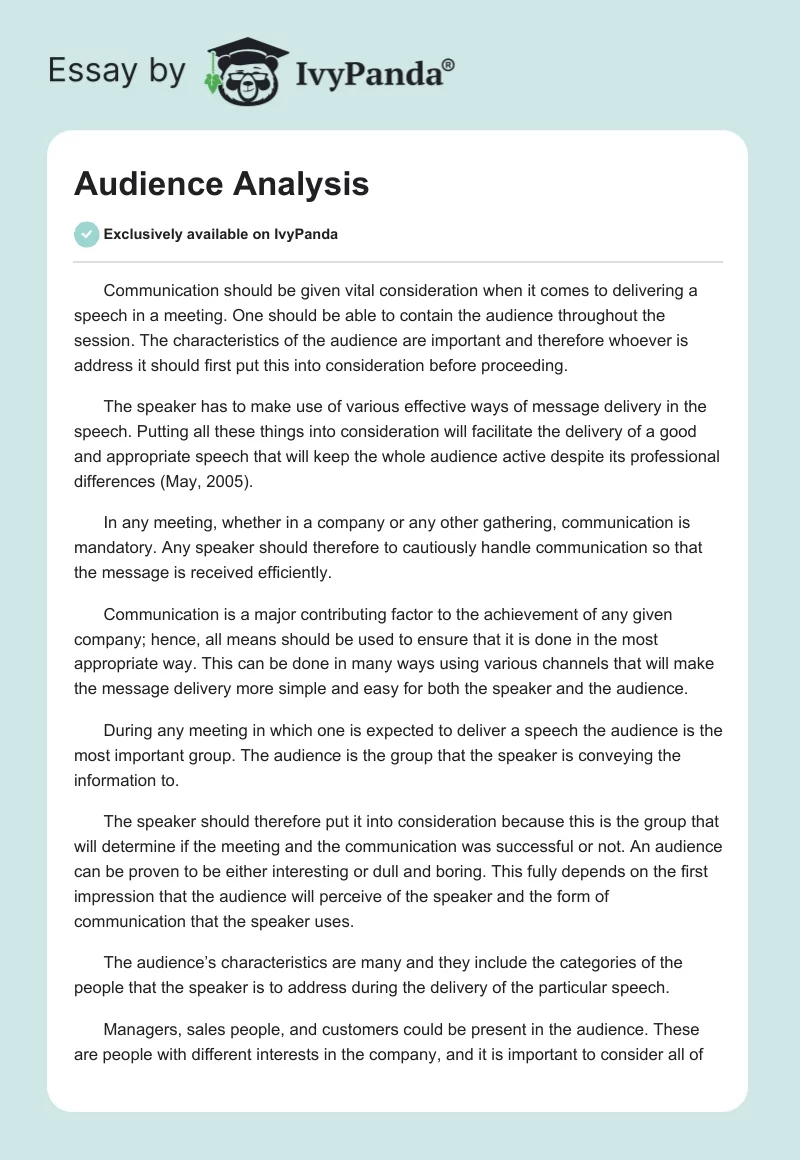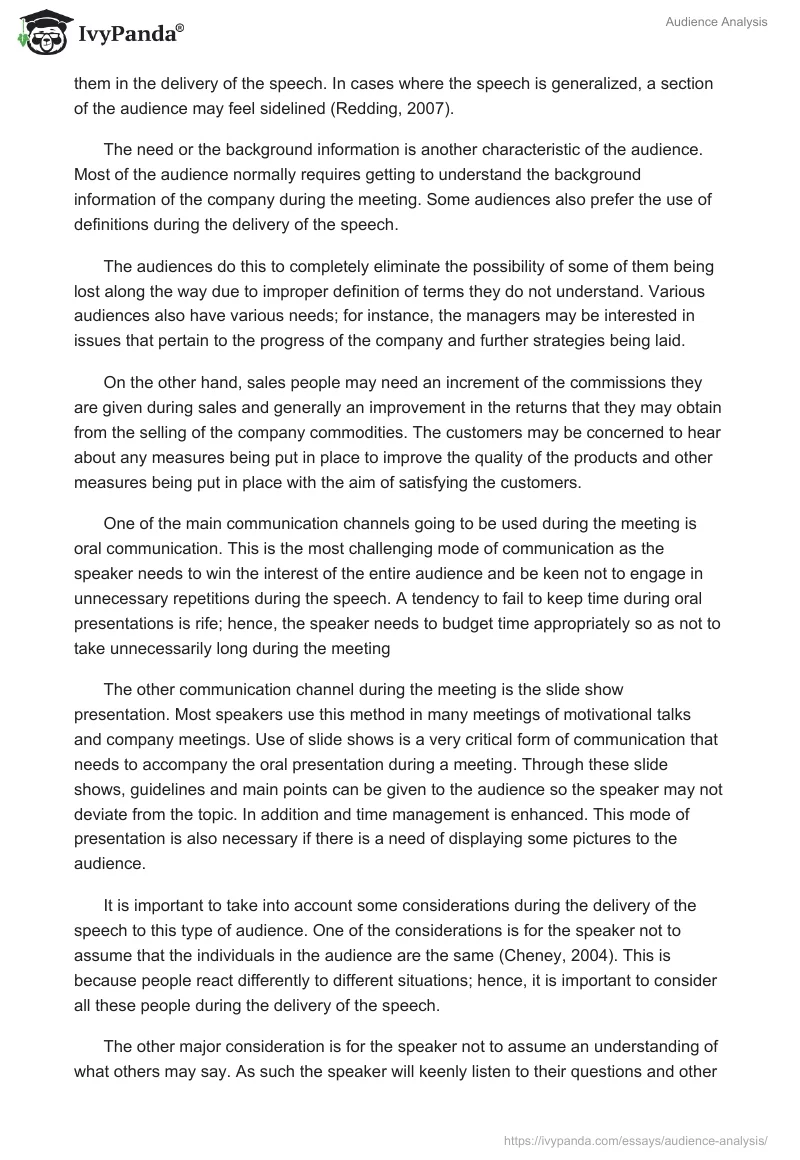Communication should be given vital consideration when it comes to delivering a speech in a meeting. One should be able to contain the audience throughout the session. The characteristics of the audience are important and therefore whoever is address it should first put this into consideration before proceeding.
The speaker has to make use of various effective ways of message delivery in the speech. Putting all these things into consideration will facilitate the delivery of a good and appropriate speech that will keep the whole audience active despite its professional differences (May, 2005).
In any meeting, whether in a company or any other gathering, communication is mandatory. Any speaker should therefore to cautiously handle communication so that the message is received efficiently.
Communication is a major contributing factor to the achievement of any given company; hence, all means should be used to ensure that it is done in the most appropriate way. This can be done in many ways using various channels that will make the message delivery more simple and easy for both the speaker and the audience.
During any meeting in which one is expected to deliver a speech the audience is the most important group. The audience is the group that the speaker is conveying the information to.
The speaker should therefore put it into consideration because this is the group that will determine if the meeting and the communication was successful or not. An audience can be proven to be either interesting or dull and boring. This fully depends on the first impression that the audience will perceive of the speaker and the form of communication that the speaker uses.
The audience’s characteristics are many and they include the categories of the people that the speaker is to address during the delivery of the particular speech.
Managers, sales people, and customers could be present in the audience. These are people with different interests in the company, and it is important to consider all of them in the delivery of the speech. In cases where the speech is generalized, a section of the audience may feel sidelined (Redding, 2007).
The need or the background information is another characteristic of the audience. Most of the audience normally requires getting to understand the background information of the company during the meeting. Some audiences also prefer the use of definitions during the delivery of the speech.
The audiences do this to completely eliminate the possibility of some of them being lost along the way due to improper definition of terms they do not understand. Various audiences also have various needs; for instance, the managers may be interested in issues that pertain to the progress of the company and further strategies being laid.
On the other hand, sales people may need an increment of the commissions they are given during sales and generally an improvement in the returns that they may obtain from the selling of the company commodities. The customers may be concerned to hear about any measures being put in place to improve the quality of the products and other measures being put in place with the aim of satisfying the customers.
One of the main communication channels going to be used during the meeting is oral communication. This is the most challenging mode of communication as the speaker needs to win the interest of the entire audience and be keen not to engage in unnecessary repetitions during the speech. A tendency to fail to keep time during oral presentations is rife; hence, the speaker needs to budget time appropriately so as not to take unnecessarily long during the meeting
The other communication channel during the meeting is the slide show presentation. Most speakers use this method in many meetings of motivational talks and company meetings. Use of slide shows is a very critical form of communication that needs to accompany the oral presentation during a meeting. Through these slide shows, guidelines and main points can be given to the audience so the speaker may not deviate from the topic. In addition and time management is enhanced. This mode of presentation is also necessary if there is a need of displaying some pictures to the audience.
It is important to take into account some considerations during the delivery of the speech to this type of audience. One of the considerations is for the speaker not to assume that the individuals in the audience are the same (Cheney, 2004). This is because people react differently to different situations; hence, it is important to consider all these people during the delivery of the speech.
The other major consideration is for the speaker not to assume an understanding of what others may say. As such the speaker will keenly listen to their questions and other contributions (Condril, 2009). In addition, nothing will be overlooked that may generate the feeling that one is ignoring a section of the audience.
As the speaker, one needs not to do things that may cause serious reactions from the audience. The questions one should ask oneself may be: Did I do anything that may have caused the individual’s or group’s reaction? (For example, common hand signals used to motion an individual to come toward you may be seen as a rude gesture in some countries).
It is also important to watch for cues that would indicate that the speaker’s behaviors or statements inadvertently were seen as threatening or insensitive. If the speaker thinks there could possibly be a misunderstanding, it is wise to assume responsibility and regroup (May, 2005).
For the delivery of an effective message, there is the need to give background information about the company at the start of the speech so as to bring all the audience at the same point of understanding. There is also a need to define important terms before proceeding with the report presentation.
The use of graphics is also critical to ensure that the message is well communicated. Graphics may include using projectors to ensure that the audience fully understands what is being handled. Lastly, for effective delivery of the message, the speaker needs to know the needs of the audience.
The speaker can do this by administering short questionnaires to the audience. This questionnaire seeks to identify the audience’s needs and will allow them to give their comments. There is need for the questionnaire to be reviewed quickly so that most important issues are handled during the speech.
Putting all the critical issues into consideration and trying as much as possible to involve all the sections of the audience will ensure that the message is fully delivered.
References
Cheney, G. (2004). Organizational Communication in an Age of Globalization. Long Grove, IL: Waveland Press.
Condril, J. (2009). Ways to Improve Your Communicatin Skills. New York: Three Rivers Press.
May, S. (2005). Engaging Organizational Communication. California: Goalminds.
Redding, W. (2007). Creator of Goal Minds. Thousand Oaks, CA: Sage.


